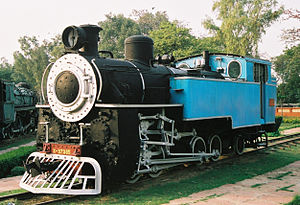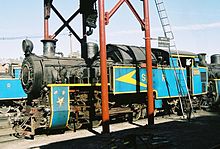- Nilgiri Mountain Railway X class
-
Nilgiri Mountain Railway X class 
Nilgiri Mountain Railway locomotive No.37385 preserved in the Delhi Railway Museum. Power type Steam Builder Swiss Locomotive and Machine Works, Winterthur, Switzerland (17)
Golden Rock Workshop, Tiruchirapalli, India (4)Build date 1914, 1920, 1925, 1952, 2011 Total produced 17 (21 including the four new 2011 ones) Configuration 0-8-2T Gauge 1,000 mm (3 ft 3 3⁄8 in) Driver diameter 815 mm (32.09 in) Fuel type Coal or Oil Fuel capacity 2011: 850 litres (190 imp gal; 220 US gal) of diesel and 2,250 litres (490 imp gal; 590 US gal) of fuel oil Cylinders Four, outside, compound High-pressure
cylinder sizeAdhesion: 450 × 410 mm (17.72 × 16.14 in) Low-pressure
cylinder sizeRack: 450 × 430 mm (17.72 × 16.93 in) Valve gear Walschaerts Top speed Adhesion: 30 km/h (19 mph)
Rack: 15 km/h (9 mph)The X class locomotives are a class of metre gauge 0-8-2T rack and pinion compound locomotives working on the Nilgiri Mountain Railway in the Nilgiri Hills of southern India. They are used on the 20 km section between Coonoor and Kallar where the gradient of the track can be as steep as 1 in 12.5. At these steep sections, the railway uses the Abt system. The X class locomotives are compound locomotives with two high-pressure and two low-pressure cylinders. All cylinders are outside the locomotive's frames. The two low-pressure cylinders drive the rack wheels. These cylinders are positioned above the two main high-pressure cylinders, which drive the main wheels.
Engines of this class were first brought as replacements for the line's original Beyer-Peacock 2-4-0 engines whose traction power was too weak for the traffic.[1][2] The X class locos were bought in two batches from the Swiss Locomotive and Machine Works, Winterthur, Switzerland. The first batch (12-nos.) were brought into operation over the years between 1920 and 1925 and the newer batch (5-nos.) in 1952.[1][3]
Table of SLM orders[4][5] SLM Works Nos. Year Quantity NMR No. All India No. Notes 2456–2459, 2469–2470 1914 6 1–6 37384 ex-No. 1 2734–2736, 2733 1920 4 7–10 37385–37388 3000–3001 1925 2 11–12 37389–37390 4069–4073 1952 5 13–17 37391–37395 Replacements
Four new oil-fired steam locomotives have been ordered to replace or ease the load on the existing X class locomotives. They too will be of basically the same design as the existing locomotives and are also described as being of the X Class. The first of these arrived in 2011.[6][7]
Conversion to oil
One locomotive, No. 37395, was modified changing it from coal to oil-fired in 2002, another has been modified and the Railway is looking to retro-fit further locomotives to oil-firing. Conversion of coal into oil-fired system has the potential to reduce the danger of forest fires that could be caused by embers flying out from the locomotive. Additionally, the effort involved in the manual lifting of coal and putting it into the boiler is eliminated. The current oil-fired locomotives need only one fireman to accompany the driver, while coal-fired engines need two firemen.[6][8][9]
References
- ^ a b Bhandari, R. R. (2008). "Steam in history". IRFCA. http://www.irfca.org/articles/isrs/isrs082004-steam-history.html. Retrieved 2 March 2010.
- ^ "Blue Mountain Railway". India for Visitors. indiaforvisitors.com. 2003. http://www.indiaforvisitors.com/travel/train/bluemountain.htm. Retrieved 2 March 2010.
- ^ "National Railway Museum". Rail in India. http://railinindia.tripod.com/nrm.html. Retrieved 2 March 2010.
- ^ Hughes 1992, p. 98
- ^ Hughes 1996, p. 58
- ^ a b Rajaram, R. (21 December 2009). "Work for manufacturing four new oil-fired steam locos begins". The Hindu (Chennai, India: The Hindu Group). http://www.hindu.com/2009/12/21/stories/2009122153510500.htm. Retrieved 2 March 2010.
- ^ Palaniappan, V.S. (Sunday, 20 February 2011). "New oil-fired locomotive for Nilgiris Mountain Railway arrives". The Hindu. http://www.hindu.com/2011/02/20/stories/2011022053670900.htm. Retrieved 8 August 2011.
- ^ "Oil fired Steam engine on Nilagiri Railway , India". Encyclopedia.com. HighBeam. 2009. http://www.encyclopedia.com/video/X8VsogADY9Y-oil-fired-steam-engine-on.aspx. Retrieved 2 March 2010.
- ^ "Retro-fitment Of Two X Class Locomotive". Indiamart. http://tenders.indiamart.com/details/991420341/. Retrieved 2 March 2010.
Categories:- Steam locomotives of India
- Compound locomotives
- 0-8-2T locomotives
- SLM locomotives
- Rack and cog driven locomotives
- Metre gauge locomotives
Wikimedia Foundation. 2010.

